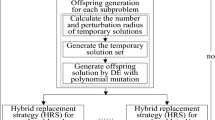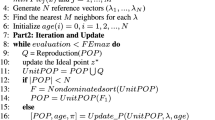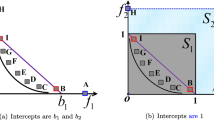Abstract
The multiobjective evolutionary algorithm based on decomposition (MOEA/D) proposed in 2007 has shown to be effective in solving multiobjective optimization problems. However, the fixed neighborhood size prevents MOEA/D series algorithm from effective exploring and exploiting. Meanwhile, since the newly generated offspring can replace the parent solutions in the neighborhood without any constraints, the current solutions of multiple subproblems may converge to a certain region or even a certain point. Obviously, the population diversity is significantly deteriorate. To alleviate these problems, this paper proposes an enhanced MOEA/D with adaptive neighborhood operator and extended distance-based environmental selection (MOEA/D-ANED) to solve many-objective optimization problems (MaOPs). The basic idea is that the adaptive neighborhood operator based on utility assignment is helpful for the algorithm to select a more promising solution, thereby enhancing the search performance in many-objective optimization. In addition, the extended distance-based environmental selection strategy is developed to considerably improve the accuracy and effectiveness of updating the parent solutions of different subproblems. Experimental results on two widely used test suits demonstrate the competitiveness of the proposed algorithm in terms of solution accuracy compared with eight state-of-the-art multiobjective optimization algorithms.




















Similar content being viewed by others
Data availability
The experimental data used to support the findings of this study are included within the article.
References
Trivedi A, Srinivasan D, Sanyal K, Ghosh A (2017) A survey of multiobjective evolutionary algorithms based on decomposition. IEEE Trans Evol Comput 21(3):440–462
Liu Y, Hu Y, Zhu N, Li K, Zou J, Li M (2021) A decomposition-based multiobjective evolutionary algorithm with weights updated adaptively. Inf Sci 572:343–377
Miettinen K (1998) Nonlinear multiobjective optimization (international series in operations research & management science). Springer, USA, p 12
Zhang M, Wang L, Guo W, Li W, Pang J, Min J, Liu H, Wu Q (2021) Many-objective evolutionary algorithm based on dominance degree. Appl Soft Comput 113:107869
Giagkiozis I, Fleming PJ (2015) Methods for multi-objective optimization: an analysis. Inf Sci 293:338–350
Qiao J, Zhou H, Yang C, Yang S (2019) A decomposition-based multiobjective evolutionary algorithm with angle-based adaptive penalty. Appl Soft Comput 74:190–205
Zhou A, Zhang Q (2016) Are all the subproblems equally important? resource allocation in decomposition-based multiobjective evolutionary algorithms. IEEE Trans Evol Comput 20(1):52–64
Deb K, Pratap A, Agarwal S, Meyarivan T (2002) A fast and elitist multi-objective genetic algorithm: NSGA-II. IEEE Trans Evol Comput 6(2):182–197
Zitzler E, Laumanns M, Thiele L (2002) SPEA2: improving the strength Pareto evolutionary algorithm for multi-objective optimization. In: Proceedings of the Evolutionary Methods for Design, Optimisation, and Control, Barcelona, CIMNE, Spain, pp. 95–100
Li M, Yang S, Liu X (2014) Shift-based density estimation for Pareto-based algorithms in many-objective optimization. IEEE Trans Evol Comput 18(3):348–365
Yang S, Li M, Liu X, Zheng J (2013) A grid-based evolutionary algorithm for many-objective optimization. IEEE Trans Evol Comput 17(5):721–736
Liu S, Yu Q, Lin Q, Tan KC (2020) An adaptive clustering-based evolutionary algorithm for many-objective optimization problems. Inf Sci 537:261–283
Wang R, Purshouse RC, Giagkiozis I, Fleming PJ (2015) The iPICEA-g: a new hybrid evolutionary multi-criteria decision making approach using the brushing technique. Eur J Oper Res 243(2):442–453
Zhou X, Wang X, Gu X (2021) A decomposition-based multiobjective evolutionary algorithm with weight vector adaptation. Swarm Evol Comput 61:1–17
Zitzler E, Künzli S (2004) Indicator-based selection in multiobjective search. Springer, Heidelberg, pp 832–842
Bader J, Zitzler E (2011) HypE: an algorithm for fast hypervolume-based many-objective optimization. Evol Comput 19(1):45–76
Beume N, Naujoks B, Emmerich M (2007) SMS-EMOA: multiobjective selection based on dominated hypervolume. Eur J Oper Res 181(3):1653–1669
Bringmann K, Friedrich T (2010) Approximating the volume of unions and intersections of high-dimensional geometric objects. Comput Geom 43(6–7):601–610
Emmerich M, Beume N, Naujoks B (2005) An EMO algorithm using the hypervolume measure as selection criterion. In: International Conference on Evolutionary Multi-Criterion Optimization, Guanajuato, Mexico, pp. 62–76
Zhang Q, Li H (2007) MOEA/D: a multiobjective evolutionary algorithm based on decomposition. IEEE Trans Evol Comput 11(6):712–731
Schaffer JD (1985) Multiple objective optimization with vector evaluated genetic algorithms. In: Proceedings of the 1st International Conference on Genetic Algorithms, pp. 93–100
Deb K, Jain H (2014) An evolutionary many-objective optimization algorithm using reference-point-based nondominated sorting approach, Part I: solving problems with box constraints. IEEE Trans Evol Comput 18(4):577–601
Li M, Yao X (2020) What weights work for you? Adapting weights for any pareto front shape in decomposition-based evolutionary multiobjective optimization. Evol Comput 28(2):227–253
Derbel B, Liefooghe A, Zhang Q, Aguirre H, Tanaka K (2016) Multi-objective local search based on decomposition. In: Handl J, Hart E, Lewis P, López-Ibáñez M, Ochoa G, Paechter B (eds) Parallel problem solving from nature – PPSN XIV PPSN 2016. Lecture notes in computer science, vol 9921. Springer, Cham
Li H, Zhang Q (2009) Multiobjective optimization problems with complicated pareto sets, MOEA/D and NSGA-II. IEEE Trans Evol Comput 13(2):284–302
Zhao S, Suganthan PN, Zhang Q (2012) Decomposition-based multiobjective evolutionary algorithm with an ensemble of neighborhood sizes. IEEE Trans Evol Comput 16(3):442–446
Zhang A, Sun G, Ren J, Li X, Wang Z, Jia X (2018) A dynamic neighborhood learning-based gravitational search algorithm. IEEE Trans Cybern 48(1):436–447
Wang L, Wu F, Zhang M, Qiu F (2017) Decomposition multi-objective evolutionary algorithm based on differentiated neighborhood strategy. Pattern Recognit Artif Intell 30(12):1069–1082
Wang R, Zhang Q, Zhang T (2016) Decomposition-based algorithms using pareto adaptive scalarizing methods. IEEE Trans Evol Comput 20(6):821–837
Deb K, Thiele L, Laumanns M, Zitzler E (2005) Scalable test problems for evolutionary multiobjective optimization. Evolutionary multiobjective optimization (theoretical advances and applications). Springer, Berlin, pp 105–145
Huband S, Hingston P, Barone L, While L (2006) A review of multiobjective test problems and a scalable test problem toolkit. IEEE Trans Evol Comput 10(5):477–506
Li K, Zhang Q, Kwong S, Li M, Wang R (2014) Stable matching-based selection in evolutionary multiobjective optimization. IEEE Trans Evol Comput 18(6):909–923
Li K, Kwong S, Zhang Q, Deb K (2015) Interrelationship-based selection for decomposition multiobjective optimization. IEEE Trans Cybern 45(10):2076–2088
Wu M, Kwong S, Jia Y, Li K, Zhang Q (2017) Adaptive weights generation for decomposition-based multi-objective optimization using gaussian process regression. In: Proceedings of the 2017 Genetic and Evolutionary Computation Conference. Berlin, Germany, 641–648
Ishibuchi H, Sakane Y, Tsukamoto N, Nojima Y (2009) Effects of using two neighborhood structures on the performance of cellular evolutionary algorithms for many-objective optimization. IEEE congress on evolutionary computation. Trondheim, Norway, pp 2508–2515
Ishibuchi H, Akedo N, Nojima Y (2013) Relation between neighborhood size and MOEA/D performance on many-objective problems. Evolutionary multi-criterion optimization (EMO) (LNCS 7811). Springer, Berlin, pp 459–474
Jiang S, Yang S (2016) An improved multiobjective optimization evolutionary algorithm based on decomposition for complex pareto fronts. IEEE Trans Cybern 46(2):421–437
Wang Z, Zhang Q, Zhou A, Gong M, Jiao L (2016) Adaptive replacement strategies for MOEA/D. IEEE Trans Cybern 46(2):474–486
Zhou H, Wang L (2017) Decomposition multiobjective evolutionary algorithm of dynamic neighborhood. J Chin Comput Syst 38(9):2039–2044
Wang L, Xu M, Yu W, Qiu Q, Wu F (2020) Decomposition multi-objective evolutionary algorithm based on adaptive neighborhood adjustment strategy. IEEE Access 8:78639–78651
Li K, Fialho Á, Kwong S, Zhang Q (2014) Adaptive operator selection with bandits for a multiobjective evolutionary algorithm based on decomposition. IEEE Trans Evol Comput 18(1):114–130
Zhang K, Shen C, Liu X, Yen G (2020) Multiobjective evolution strategy for dynamic multiobjective optimization. IEEE Trans Evol Comput 24(5):974–988
Farias LRC, and Araújol AFR (2019) Many-objective evolutionary algorithm based on decomposition with random and adaptive weights. In: IEEE International Conference on Systems, Man and Cybernetics (SMC), pp. 3746–3751
Wang P, Liao B, Zhu W, Cai L, Ren S, Chen M, Li Z, Li K (2018) Adaptive region adjustment to improve the balance of convergence and diversity in MOEA/D. Appl Soft Comput 70:797–813
Cheng R, Jin Y, Olhofer M, Sendhoff B (2016) A reference vector guided evolutionary algorithm for many-objective optimization. IEEE Trans Evol Comput 20(5):773–791
Jiang S, He X, Zhou Y (2019) Many-objective evolutionary algorithm based on adaptive weighted decomposition. Appl Soft Comput 84(105731):1–11
Li H, Zhang Q, Deng J (2017) Biased multi-objective optimization and decomposition algorithm. IEEE Trans Cybern 47(1):52–66
Zhang Q, Liu W, Li H (2009) The performance of a new version of MOEA/D on CEC09 unconstrained MOP test instances. In: IEEE Congress on Evolutionary Computation, pp. 203–208
Liu H, Gu F, Zhang Q (2014) Decomposition of a multiobjective optimization problem into a number of simple multiobjective subproblems. IEEE Trans Evol Comput 18(3):450–455
Tian Y, Cheng R, Zhang X, Jin Y (2017) PlatEMO: A MATLAB platform for evolutionary multi-objective optimization [educational forum]. IEEE Comput Intell Mag 12(4):73–87
Wang Y, Cai Z, Zhang Q (2011) Differential evolution with composite trial vector generation strategies and control parameters. IEEE Trans Evol Comput 15(1):55–66
Zitzler E, Thiele L, Laumanns M, Fonseca CM, da Fonseca VG (2003) Performance assessment of multiobjective optimizers: an analysis and review. IEEE Trans Evol Comput 7(2):117–132
Schutze O, Esquivel X, Lara A, Coello CAC (2012) Using the averaged hausdorff distance as a performance measure in evolutionary multiobjective optimization. IEEE Trans Evol Comput 16(4):504–522
Zhang Q, Zhou A, Jin Y (2008) A RM-MED, a regularity model-based multiobjective estimation of distribution algorithm. IEEE Trans Evolut Comput 12(1):41–63
Zitzler E, Thiele L (1999) Multiobjective evolutionary algorithms: a comparative case study and the strength pareto approach. IEEE Trans Evol Comput 3(4):257–271
Li K, Wang R, Zhang T, Ishibuchi H (2018) Evolutionary many-objective optimization: a comparative study of the state-of-the-art. IEEE Access 6(26):194–214
Tan KC, Chew YH, Lee LH (2006) A hybrid multi-objective evolutionary algorithm for solving vehicle routing problem with time windows. Comput Optim Appl 34(1):115–151
Solomon MM (1987) Algorithms for the vehicle routing and scheduling problems with time window constraints. Oper Res 35(2):254–265
Acknowledgements
This research is partly supported by the National Natural Science Foundation of China under Project Code (62176146, 61773314), and the Special project of Education Department of Shaanxi Provincial Government for Local Services (Program No. 21JC026).
Author information
Authors and Affiliations
Contributions
All authors contributed to the study conception and design. The algorithm design and implementation were performed by WL. Experiment and analysis were performed by JY. LW revised the manuscript. All authors read and approved the final manuscript.
Corresponding author
Ethics declarations
Conflict of interest
The authors declare that they have no conflict of interest.
Additional information
Publisher's Note
Springer Nature remains neutral with regard to jurisdictional claims in published maps and institutional affiliations.
Rights and permissions
Springer Nature or its licensor (e.g. a society or other partner) holds exclusive rights to this article under a publishing agreement with the author(s) or other rightsholder(s); author self-archiving of the accepted manuscript version of this article is solely governed by the terms of such publishing agreement and applicable law.
About this article
Cite this article
Li, W., Yuan, J. & Wang, L. An enhanced decomposition-based multiobjective evolutionary algorithm with adaptive neighborhood operator and extended distance-based environmental selection. J Supercomput 79, 12341–12393 (2023). https://doi.org/10.1007/s11227-023-05118-1
Accepted:
Published:
Issue Date:
DOI: https://doi.org/10.1007/s11227-023-05118-1




